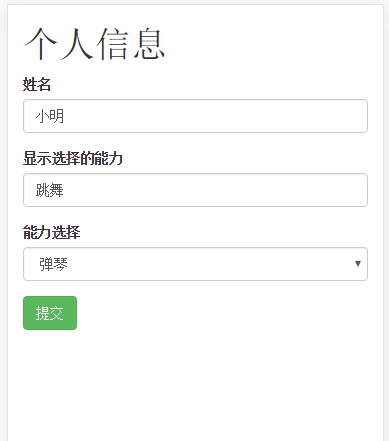表单创建一个有效、引人注目的数据输入体验。Angular表单协调一组数据绑定控件,跟踪变更。验证输入的有效性,并且显示错误信息。
接下来,主要内容有:
1、使用组件和模板构建Angular表单;
2、用ngModel创建数据绑定,以读取和写入输入控件的值。
构建Angular表单
我们想构建包含姓名,电话,特长三个字段的表单
1、我们可以参照快速启动那篇,创建一个名为forms的新项目,也可以使用之前的项目进行修改;
2、创建Person类;
3、创建控制此表单的组件;
4、创建具有初始表单布局的模板;
5、使用ngModel双向数据绑定语法把数据属性绑定到每个表单控件中。
创建Person类
在app文件夹下创建hero.ts文件,内容为
export class Person{
constructor(
public id:number,
public name:string,
public ownpower:string,
public power?:string //可填可不填,可选的 ?不能省略
){}
}
//创建一个类,定义它的属性
TypeScript编译器为每个public构造函数参数生成一个公共字段,在创建一个新的Person实例时,自动把参数赋给这些公共字段。
创建表单组件
在app文件夹下创建hero-form-component.ts文件:
import { Component } from '@angular/core';
import {Person} from './hero'; //引入hero.ts中的Person类
@Component({
moduleId:module.id,//属性设置了基地址,用于从相对路径加载form.html模板文件
selector: 'hero-form',//在模板中创建添加<hero-form>标签
templateUrl:'../form.html'//模板上增加form.html里面的内容
})
export class HeroFormComponent {
powers=['唱歌','跳舞','弹琴','画画'];
model=new Person(1,'小明','跳舞',this.powers[2]);//实例化
submitted=false;
onsubmit(){this.submitted=true;}
get diagnostic(){return JSON.stringify(this.model);} //这个先暂时不管
}
1、这段代码导入了Angular核心库以及我们刚刚创建的Person模型;
2、@Component装饰器的选择器将<hero-form>标签把这个表单放进父模板;
3、moduleId:module.id属性设置了基地址,用于从相对模块路径加载templateUrl;
4、templateUrl属性指向一个独立的HTML模板文件,使用外联模板;
5、位model和powers提供了演示用的假数据;
6、在最后增加diagnostic属性,她返回这个模型的JSON形式。在开发过程中用于调试。
修改app.module.ts启动文件
import { NgModule } from '@angular/core';
import { BrowserModule } from '@angular/platform-browser';
import {FormsModule} from '@angular/forms';//导入表单
import { AppComponent1 } from './app.component';
import{HeroFormComponent} from './hero-form.component';//导入新增加的组件类
//导入hero-form.component.ts中的HeroFormComponent
@NgModule({
imports: [
BrowserModule,
FormsModule //表单模板
],
declarations: [
AppComponent1 ,
HeroFormComponent //类名
],
bootstrap: [AppComponent1]
})
export class AppModule { }
1、导入FormsModule和新组件HeroFormComponent;
2、把FormModule添加到ngModel装饰器的imports列表中,这样应用就能访问模板驱动表单的所有特性,包括ngModel;
3、把HeroFormComponent添加到ngModule装饰器的declarations列表中,使HeroFormComponent组件在整个模块中可见。
修改app.component.ts文件
import { Component } from '@angular/core';
@Component({
selector: 'my-app',//在index.html中创建添加<my-app>标签
//包裹<hero-form></hero-form>
template:`<hero-form></hero-form>`
//模板里面添加此标签(hero-form里面的内容)
})
export class AppComponent1{}
关于表单的组建模板构建完了。
创建初始HTML表单模板,上文提到的form.html文件
<!DOCTYPE html>
<html lang="en">
<head>
<meta charset="UTF-8">
<title>form表单</title>
</head>
<body>
<div class="container">
<h1>个人信息</h1>
<form>
<div class="form-group">
<label for="name">姓名</label>
<input type="text" id="name" required class="form-control">
</div>
<div class="form-group">
<label for="ownpower">特长</label>
<input type="text" class="form-control" id="ownpower">
</div>
<div class="form-group">
<label for="power">能力选择</label>
<select class="form-control" id="power" required>
<!--循环-->
<option *ngFor="let pow of powers" [value]="pow">{{pow}}</option>
</select>
</div>
<button type="submit" class="btn btn-success">提交</button>
</form>
</div>
</body>
</html>
我们可以使用css来美化表单,在index.html里面引入样式表文件
<!--样式表--> <link rel="stylesheet" href="css/bootstrap.min.css">
显示的效果为

使用ngModel进行双向数据绑定[(ngModel)]语法
修改form.html文件,拿姓名做个实例
<div class="form-group">
<label for="name">姓名,显示为{{model.name}}</label>
<input type="text" id="name" required class="form-control" [(ngModel)]="model.name" name="name" #name1="ngModel">
<!--双向绑定:{{model.name}}-->
<!--使用ngModwl进行双向绑定,其绑定了model.name,所以所有有model。name的都可以同时变化-->
</div>
效果为

好了,一个简单的表单就做好了,下一篇讲控制表单,校验错误等内容。
参考:https://angular.cn/docs/ts/latest/guide/forms.html
以上就是本文的全部内容,希望对大家的学习有所帮助,也希望大家多多支持好代码网。


